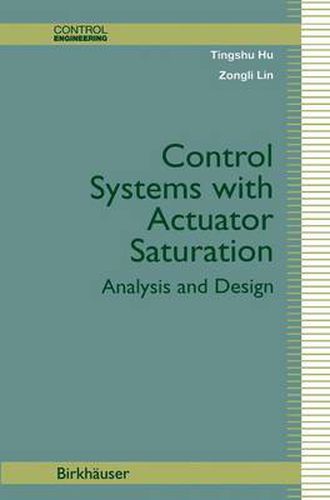Readings Newsletter
Become a Readings Member to make your shopping experience even easier.
Sign in or sign up for free!
You’re not far away from qualifying for FREE standard shipping within Australia
You’ve qualified for FREE standard shipping within Australia
The cart is loading…






This title is printed to order. This book may have been self-published. If so, we cannot guarantee the quality of the content. In the main most books will have gone through the editing process however some may not. We therefore suggest that you be aware of this before ordering this book. If in doubt check either the author or publisher’s details as we are unable to accept any returns unless they are faulty. Please contact us if you have any questions.
Saturation nonlinearities are ubiquitous in engineering systems. In control systems, every physical actuator or sensor is subject to saturation owing to its maximum and minimum limits. A digital filter is subject to saturation if it is implemented in a finite word length format. Saturation nonlinearities are also purposely introduced into engineering systems such as control sys tems and neural network systems. Regardless of how saturation arises, the analysis and design of a system that contains saturation nonlinearities is an important problem. Not only is this problem theoretically challenging, but it is also practically imperative. This book intends to study control systems with actuator saturation in a systematic way. It will also present some related results on systems with state saturation or sensor saturation. Roughly speaking, there are two strategies for dealing with actuator sat uration. The first strategy is to neglect the saturation in the first stage of the control design process, and then to add some problem-specific schemes to deal with the adverse effects caused by saturation. These schemes, known as anti-windup schemes, are typically introduced using ad hoc modifications and extensive simulations. The basic idea behind these schemes is to intro duce additional feedbacks in such a way that the actuator stays properly within its limits. Most of these schemes lead to improved performance but poorly understood stability properties.
$9.00 standard shipping within Australia
FREE standard shipping within Australia for orders over $100.00
Express & International shipping calculated at checkout
This title is printed to order. This book may have been self-published. If so, we cannot guarantee the quality of the content. In the main most books will have gone through the editing process however some may not. We therefore suggest that you be aware of this before ordering this book. If in doubt check either the author or publisher’s details as we are unable to accept any returns unless they are faulty. Please contact us if you have any questions.
Saturation nonlinearities are ubiquitous in engineering systems. In control systems, every physical actuator or sensor is subject to saturation owing to its maximum and minimum limits. A digital filter is subject to saturation if it is implemented in a finite word length format. Saturation nonlinearities are also purposely introduced into engineering systems such as control sys tems and neural network systems. Regardless of how saturation arises, the analysis and design of a system that contains saturation nonlinearities is an important problem. Not only is this problem theoretically challenging, but it is also practically imperative. This book intends to study control systems with actuator saturation in a systematic way. It will also present some related results on systems with state saturation or sensor saturation. Roughly speaking, there are two strategies for dealing with actuator sat uration. The first strategy is to neglect the saturation in the first stage of the control design process, and then to add some problem-specific schemes to deal with the adverse effects caused by saturation. These schemes, known as anti-windup schemes, are typically introduced using ad hoc modifications and extensive simulations. The basic idea behind these schemes is to intro duce additional feedbacks in such a way that the actuator stays properly within its limits. Most of these schemes lead to improved performance but poorly understood stability properties.